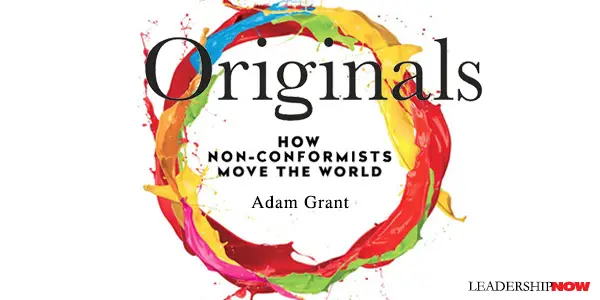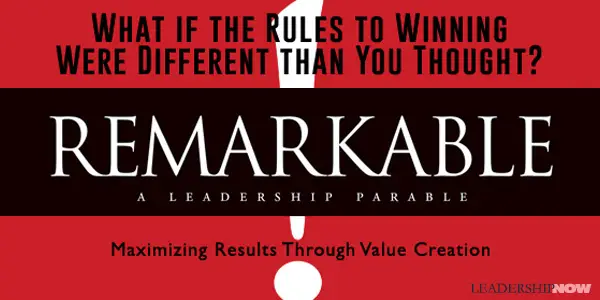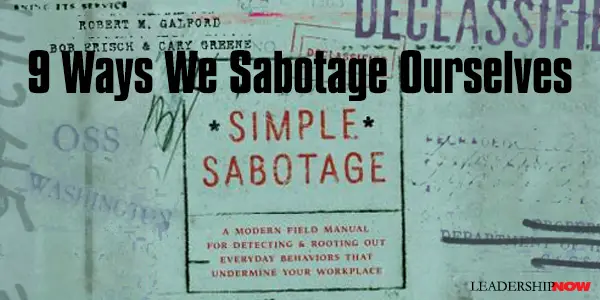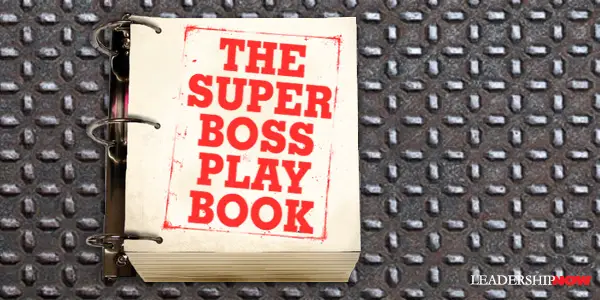 Leading Blog | Posts by Month |
 Leading Blog | Posts by Month |
02.29.16

LeadershipNow 140: February 2016 Compilation
See more on
Posted by Michael McKinney at 01:52 AM
02.26.16

Originals or How Non-Conformists Move the World
THERE ARE SO FEW originals in life. “We find surface ways of appearing original—donning a bow tie, wearing bright red shoes—without taking the risk of actually being original. When it comes to the powerful ideas in our heads and the core values in our hearts, we censor ourselves.” Originals by Adam Grant—a professor at the University of Pennsylvania’s Wharton business school—is about the people who choose to champion originality and move us forward. They are not that different from the rest of us, but in spite of inner doubts and a world geared toward uniformity, they press on and change the world. For most of us we are not like the conceptual innovators that formulate a big idea early on in life and act on it. We are probably more like the experimental innovators that move through idea after idea, learning and evolving as they go. “While experimental innovation can require years or decades to accumulate the requisite knowledge and skill.” writes Grant, “it becomes a more sustainable source of originality.” Interestingly, it is not the child prodigies that go on to change the world. While they are rich in talent an ambition, they don’t learn to be original. “Practice makes perfect, but it doesn’t make new.” Most prodigies never make the leap to originality. “They apply their extraordinary abilities in ordinary ways, mastering their jobs without questioning defaults and without making waves.” How Do We Get More Original Ideas? If you want to do original work, do more work. “On average, creative geniuses weren’t qualitatively better in their fields than their peers. They simply produced a greater volume of work, which gave them more variation and a higher chance of originality.” Quantity is the most predictable path to quality. Our most brilliant work will be found in the mass of our less brilliant work. It is important to mention also that originals expose themselves to influences far outside their official arena of expertise. Nobel Prize winners are “dramatically more likely to be involved in the arts than less accomplished scientists.” Notice more and look for connections. How Do We Bridge the Gap between Insight and Action? The best judges of creative ideas are fellow creators. Fellow creators are more open to original ideas. “The more expertise and experience people gain, the more entrenched they become in a particular way of viewing the world.” Critical reviews are often viewed as better—more intelligent. “Prophets of doom and gloom appear wise and insightful.” Too much optimism comes across as salesmanship. No one wants to be sold. When you are trying to sell an original idea people are looking to reasons why it won’t work. Next time try presenting a candid discussion of your ideas weaknesses. In trying to sell investors on his company Babble, Rufus Griscom described the hurdles he faced in his own business. He came across not only as knowledgeable, but also honest and modest. “When I led with the factors that could kill the company, the response from the board was the exact opposite: oh, these things aren’t so bad.” We often undercommunicate our ideas because we are so familiar with them that we think there is no need to repeat them. Our audience needs more exposure to accept them. Developing Original Ideas Procrastination can improve our creativity. In one example Grant notes, “It was only when they began thinking about the task and then deliberately procrastinated that they considered more remote possibilities and generated more creative ideas. Delaying progress enable them to spend more time considering different ways to accomplish it, rather than ‘seizing and freezing’ on one particular strategy.” Being original doesn’t mean being first. “It just means being different and better.” When originals try to be first they tend to overstep. They move before the market can support their idea. They tend to take bigger risks and are prone to make impulsive decisions. “When you are the first to market, you have to make all of the mistakes yourself.” Those that follow can more easily learn from you mistakes and improve on your idea. When presenting original ideas they can’t be seen as too radical or people will never accept them. When selling them you have to give people something to connect with. “Instead of assuming that others share our principles, or trying to convince them to adopt ours, we ought to present our values as a means of pursuing theirs. It’s hard to change other people’s ideals. It’s much easier to link our agendas to familiar values that people already hold.” How to Build a Culture of Originality Too many rules and they way we understand them can greatly affect our creativity. “In one study, parents of ordinary children had an average of six rules, like specific schedules for home work and bedtime. Parents of highly creative children had an average of less than one rule and tended to ‘place emphasis on moral values, rather than on specific rules.’” Grant also adds: If parents do believe in enforcing a lot of regulations, the way they explain them matters a great deal. New research shows that teenagers defy rules when they’re enforced in a controlling manner, by yelling or threatening punishment. When mothers enforce many rules but offer a clear rationale for why they’re important, teenagers are substantially less likely to break them, because they internalize them. In this regard, nouns are better than verbs. It’s better to ask children to be helpers than ask them to help. It speaks to their identity. In the same way being told not to cheat is not as effective than saying “Please don’t be a cheater.” Dealing with Groupthink Cohesion in a group doesn’t cause groupthink. “There’s a fine line between having a strong culture and operating like a cult.” When organizational performance is down, leaders tend to search for people who share their perspective. When what they need to do is look for advice that challenges them. “If you’re going to build a strong culture, it’s paramount to make diversity one of your core values.” It’s what separates a strong culture from a cult. You need a loyal opposition. You need a devil’s advocate. But here’s the thing, you need to find one, not assign one. “When people are designated to dissent, they are just playing a role. This causes two problems: They don’t argue forcefully or consistently enough for the minority viewpoint, and group members are less likely to take them seriously. But when it is authentic, it stimulates thought; it clarifies and it emboldens.” To keep this process constructive, organizations must prioritize their values. This provides a framework for new ideas. “The more principles you have, the greater the odds that employees focus on different values or interpret the same values differently.” In Originals, Grant utilizes new examples and counterintuitive research to inspire us to lead—to change the world. He concludes with 30 Actions for Impact for unleashing originality.
Of Related Interest:

Posted by Michael McKinney at 12:37 PM
02.24.16

10 Ways You Earn Respect ONE of the critical lessons I’ve learned in life - and it extends beyond the workplace - is the importance of respect. This may seem old-fashioned or trite in the days of, “I got mine, go get yours,” but if you treat people right, you will get the results you want. This is especially true in business. Respect still matters!
ONE of the critical lessons I’ve learned in life - and it extends beyond the workplace - is the importance of respect. This may seem old-fashioned or trite in the days of, “I got mine, go get yours,” but if you treat people right, you will get the results you want. This is especially true in business. Respect still matters!
Great leaders appreciate every job that is done well; it doesn’t matter whether it’s in the C-suite or the mailroom. Great leaders also understand that respect isn’t an entitlement linked to a particular job title. They need to respect others before others will respect them. So, how do you earn respect in business? Here are 10 ways:
 
Posted by Michael McKinney at 02:51 PM
02.22.16

5 Leadership Lessons: What if the Rules to Winning Were Different than You Thought?
WHAT IF GIVING VALUE beat extracting value every time? What is seeing others succeed was the greatest reward? It is a Remarkable! culture that does that every time. A Remarkable! culture is one where people believe the best in one another, want the best for one another, and expect the best from one another. 

Posted by Michael McKinney at 12:56 AM
02.19.16

9 Ways We Sabotage Ourselves
FROM PEOPLE whose job it is to sabotage the efforts of others, we can take a lesson or two. In Simple Sabotage, authors Robert Galford, Bob Frisch, and Cary Greene explain that in January 1944 the OSS (Office of Strategic Services—predecessor of the CIA) published the Simple Sabotage Field Manual (PDF) to train resistance members in the art of sabotage. “The Manual detailed easy ways to disrupt and demoralize the enemy’s institutions without being detected.” One section of the Manual provided eight tactics specifically designed to disrupt the enemy’s organizations. The authors have added a ninth in keeping with the times. One thing you will notice from each of these tactics or behaviors is that none of them are all that bad on the surface. One could easily find a rational explanation for engaging in them—to a point. And that’s the problem. That’s why these are insidious. Too often we insist on reproducing a behavior long after the sell-by date. We don’t let it go when we should and so we unwittingly sabotage our best efforts. Here are nine acts of sabotage we unintentionally get caught up in: Sabotage by Obedience Insist on doing everything through channels. Never permit shortcuts to be taken in order to expedite decisions. Sabotage by Speech Make “speeches.” Talk as frequently as possible and at great length. Illustrate your “point” by long anecdotes and accounts of personal experiences. Sabotage by Committee When possible, refer all matters to committees, for “further study and consideration.” Attempt to make the committees as large as possible—never less than five. Sabotage by Irrelevant Issues Bring up irrelevant issues as frequently as possible. Sabotage by Haggling Haggle over precise wordings of communications, minutes, resolutions. Sabotage by Reopening Decisions Refer back to matters decided upon at the last meeting and attempt to reopen the question of the advisability of that decision. Sabotage by Excessive Caution Advocate “caution.” Be “reasonable” and urge your fellow conferees to be “reasonable” and avoid haste, which might result in embarrassments or difficulties later on. Sabotage by Is-It-Really-Our-Call? Be worried about the propriety of any decision—raise the question of whether such action as is contemplated lies within the jurisdiction of the group or whether it might conflict with the policy of some higher echelon. Sabotage by CC: Everyone CC: Everyone. Send updates as frequently as possible, including in the distribution list anyone even peripherally involved. In each chapter, the authors use examples to help you identify the behavior and root it out—which is not as simple as you might think. Perpetrators can easily defend their behavior, but that’s what makes these behaviors so effective. For the same reason, it is also difficult to see in ourselves. Simple Sabotage is about the day-to-day routine interactions and processes we rely on as we work that are undermined by unintentional sabotage. By identifying and removing the hundreds or even thousands of small, barely perceptible irritants—the “sand” that clogs the machinery—you will transform your workplace or workgroup experience and the experience of those around you. 
Posted by Michael McKinney at 10:15 AM
02.16.16

The Superboss Playbook
IMAGINE A WORLD a world where the person who you call your boss changed your life by helping you accomplish more than you ever thought possible. In every industry there is a leader that stands out. A Superboss. What is their secret?In Superbosses, Sydney Finkelstein discovered that although they may differ in leadership styles, they share a playbook that leads to extraordinary success founded on making other people successful. Superbosses can be fierce or gentle, belligerent or self-depreciating, but whatever their style, they do a much better job inspiring and teaching because they get in their trenches with protégés, leading by example and giving them personalized attention they require to move up quickly. Here then is the outline of The Superboss Playbook – Techniques, Mind-Sets, Philosophies, and Secrets of the World’s Best Bosses: Superbosses recruit people who “get it.” Superbosses are uncompromisingly open. Superbosses embrace the apprenticeship model. Superbosses are traders in opportunities. Superbosses fashion teams that function as a “band of brothers.” Superbosses create a strategic alumni network. We need new approaches to nurturing people and the Superboss Playbook presented by Finklestein, is completely learnable by any leader who is fearless, competitive, imaginative, credible, and authentic. Superbosses is a fascinating look at the leaders that flourish and often change their industries by developing a future generation of leaders. If you are not working for one, this book will help you to become one. The Three Types of Superbosses Glorious Bastards: These superbosses care about one thing: winning. They’re the ultimate hard drivers, yet they realize that to get the very best results, they need to develop the world’s best people and teams. So they do.
Nurturers: These coaches and teachers resemble traditional mentors the most. They take pride in bringing others along and care deeply about the success of their protégés. They help people accomplish more than they ever thought possible.
Iconoclasts: These executives usually operate in creative fields, where their single-minded passion for their work inspires their protégés.
Available too, is The Superbosses Playbook: A Workbook Companion to Superbosses. It shows readers how to apply the tactics of these "superbosses" in their own organizations. It features assessments, case studies, and exercises designed to help anyone recruit talent, lead performance, inspire teams, and even part with great people like a true superboss. 
Posted by Michael McKinney at 08:40 PM
02.01.16

First Look: Leadership Books for February 2016Here's a look at some of the best leadership books to be released in February.




For bulk orders call 1-800-423-8273  Build your leadership library with these specials on over 100 titles. All titles are at least 40% off the list price and are available only in limited quantities. “Seeing a book on my shelf reconnects me to the ideas inside. And that’s why I read.” — Michael Hyatt
Posted by Michael McKinney at 02:37 PM
|
BUILD YOUR KNOWLEDGE


How to Do Your Start-Up Right STRAIGHT TALK FOR START-UPS 
Grow Your Leadership Skills NEW AND UPCOMING LEADERSHIP BOOKS 
Leadership Minute BITE-SIZE CONCEPTS YOU CAN CHEW ON 
Classic Leadership Books BOOKS TO READ BEFORE YOU LEAD |
|